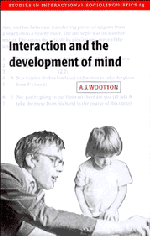Book contents
1 - Overview of arguments and procedures
Published online by Cambridge University Press: 24 August 2009
Summary
Several strands of social theory have long insisted on the existence of social facts. These are normally thought of as features of social organization which shape the actions of individuals whilst, at the same time, being in some sense independent of those individuals. Within my home discipline, sociology, the most famous articulation of such a position is in the writings of Durkheim (1901/1938). For him the representations of the ‘collective conscience’, the stuff of law, customs and such like, are separable from individual representations, those which are person specific, even though both co-exist within particular human practices. The business of sociology was to be the analysis of collective representations, and, by implication, the study of childhood becomes an occasion for examining how these representations are acquired by the child; he writes, for example, that education is ‘a continuous effort to impose on the child ways of seeing, feeling and acting at which he would not have arrived spontaneously’ (1938:6, cited in Lukes 1973:12).
If we accept that human thought and action are informed by the existence of some such shared social component the question then arises as to how the young child gains access to it.
- Type
- Chapter
- Information
- Interaction and the Development of Mind , pp. 1 - 26Publisher: Cambridge University PressPrint publication year: 1997



